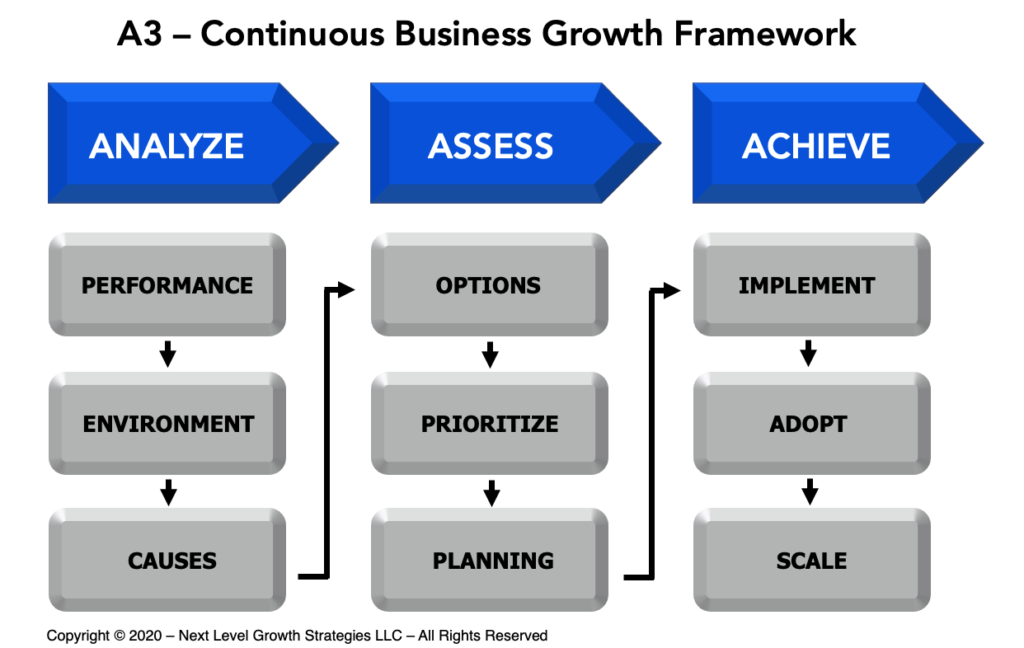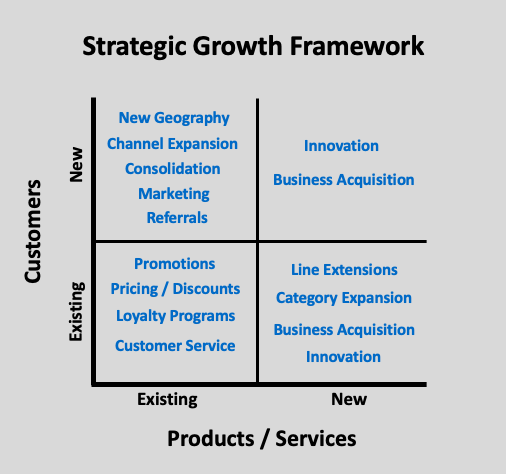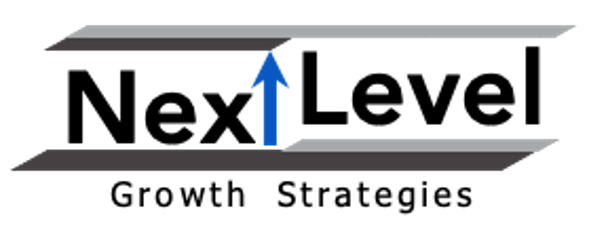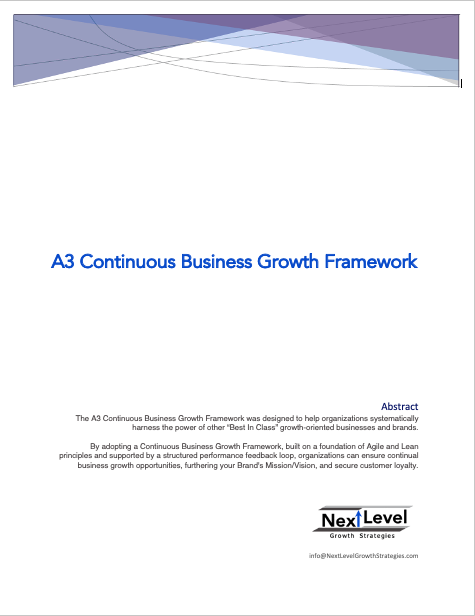A3 – Continuous Business Growth Framework
Philosophically, we at Next Level Growth Strategies believe that there is a Universal Purpose for every organization or brand. That being the continual pursuit of creating new value for its customers and stakeholders (however you happen to define stakeholder). And a result of continually delivering upon this purpose, organizations are in turn, successful and continue to grow – creating even more value.
Organizations that have been the most successful at doing this have several things in common. They embody a growth orientation or mindset, they foster a learning culture, are customer-centric, data-driven, focus on quality, and employ a repeatable process that enables successful future growth.
Over the years, we’ve developed a framework called the A3 Continuous Business Growth Framework to help organizations systematically harness the power of other “Best In Class” growth-oriented businesses and brands.
This framework focuses on identifying and delivering sustainable value throughout the entire Value Stream by bringing the right data and insights together and making new connections in a way that creates new value for your customers and stakeholders. This framework integrates “current thinking” with “future thinking” and creates an effective and efficient pipeline of growth-oriented, value-creating activities.
The A3 Continuous Business Growth Framework outlined here is comprised of three phases, each having three steps that build successively on each previous step – effectively becoming a flywheel for ongoing business growth. The three phases are: Analyze, Assess and Achieve which are based on Agile and Lean principles.

It is vital that the goals and structure of the A3 Continuous Business Growth Framework are 100% aligned with your organization’s Mission, Vision, Purpose, and Identity – and that these are well understood and fully agreed upon throughout the entire enterprise. Without this, it is highly unlikely that the A3 Continuous Business Growth Framework can successfully deliver new value on an ongoing basis. However, adopting and adapting this framework will ensure that all new opportunities are connected to (and support) your organization’s overarching goals, objectives, and culture.
Questions for success:
- Is there 100% alignment throughout the organization about our Brand’s Mission, Vision, Purpose, and Identity?
- What have been the past sources for new business growth?
- Do we have a growth-oriented portfolio approach to strategic planning that involves all stakeholders?
- Have we established acceptance criteria for pursuing new growth initiatives?
- Can we articulate our growth objectives and processes?
- Do we currently employ Agile and Lean processes?
Steps for Success:
Step 1 – Strategic Focus
Your growth strategy must support and amplify your organization’s goals and objectives, and you must understand what’s right for your business. This strategy relates to the types of initiatives you elect to pursue and the mix or portfolio of new growth-focused initiatives. Your organization’s culture, business model, and current performance will often determine the amount and types of risk you are willing to undertake. Keep in mind that most organizations focus the majority of their efforts on maintaining and refining existing products, services and processes and allocate only a small percent of their resources towards disruptive forward-looking initiatives.
Step 2 – Growth & Value Creation Goals
Once you’ve determined the “right” mix of growth-oriented initiatives, you now have to understand your boundaries and establish what “success” looks like. Each initiative’s goals will be dependent upon the type of initiative – that is: Optimizing, Expanding, and Establishing new products, services, processes, and capabilities. Leveraging the construct of the Strategic Growth Framework (illustrated below) is useful for this.

And at a minimum, revenue and profit delivery and cost targets need to be established for every initiative.
Step 3 – Create and Adopt Business Growth Framework
Every organization must realize that growth doesn’t just happen on its own. And likewise, a growth-focused culture doesn’t come naturally for every organization. However, with the right leadership, framework and processes, these competencies can be developed over time. Establishing a Continuous Business Growth Framework that best fits your company’s culture is critical to success.
ANALYZE
The ANALYZE phase goal is to paint a comprehensive picture of the business’ current situation – inside and out. And establish a more thorough understanding of performance drivers.
Questions for Success:
- What are our leading and lagging business performance metrics?
- Have we identified all possible external sources that affect our business performance?
- Who is our target customer?
- What customer data and metrics help us better understand our business performance?
- How are our key competitors performing?
- Are their new market entrants flying below the radar screen that we need to be aware of?
- Do we understand all potential unmet and underserved customer needs?
- For all questions above, what’s different, what’s the same, and why?
Steps for Success:
1) PERFORMANCE
This step is an internal look at HOW the business is performing? It’s a review/reporting of the organization’s Key Performance Metrics – Financial, Operating, Brand, Employee, Customer, etc. benchmarked against the plan and prior performance.
2) ENVIRONMENT
This is a comprehensive look outside the organization. WHAT are potential external influences on the company? Economy, Consumers, Competitors, Suppliers, Media, Regulations, etc.
- What’s changed?
- What’s the same?
- What’s expected to change?
3) CAUSES
The Causes step is about connecting the internal and external dots and creating a deeper understanding about WHY the business is performing the way it is.
ASSESS
In the ASSESS phase, we explore all the potential options for creating new consumer value and determine which ones make the most sense for the organization to pursue immediately, in the future, or not at all.Also, we establish our implementation and measurement plans for creating this new growth opportunity.
Questions for Success:
- Have we included all of the right people in our idea and solution discovery processes?
- Are we looking at the big picture (our entire Value Stream) when designing potential solutions?
- How are we thinking about and leveraging existing solutions and capabilities to satisfy unmet or underserved customer needs?
- Are our best (most valuable) customers early adopters? If so, how are our solutions designed to satisfy their wants and needs?
- Do we have an understood and agreed-upon process for evaluating and prioritizing potential initiatives?
Steps for Success:
1) OPTIONS
In the Options step of the ASSESS phase, we’re focused on coming up with an array of potential ideas to create new customer value and deliver new business growth. Using all of the information and insights from the ANALYZE phase, we identify as many things as possible that can create new business growth by:
- Expanding – Doing more of what we’re already doing
- Optimizing – Refining existing aspects of our operating / value delivery model
- Establishing – Creating / Doing / Launching something completely new
2) PRIORITIZE
In the prioritize step, we evaluate each potential opportunity based on an objective scoring process – known as NABR – and select the initiatives we will pursue during the next strategic growth development cycle.
- Needs – What is the important consumer or market need that we intend to address, why is it important? And how important is it?
- Approach – What is our unique approach (idea) for delivering against this unmet or underserved need?
- Benefits – What are the benefits (to the consumer and to the organization) net of costs?
- Risks – What are the risks to the organization of pursuing (or not pursuing) this opportunity? Is there a risk of someone else doing it if we don’t, and will that cost us market share? How defensible is our solution – can someone else quickly and easily copy it? Do we have the ability to do it better and more efficiently than anyone else?
3) PLANNING
In the planning step, cross-functional teams come together to create their implementation plans. Utilizing an Agile Workshop approach, the teams scope out their resources, dependencies, workstreams, and timelines. It is also essential to reserve flex capacity (20%-25% of total planned hours) for their growth cycle plans to accommodate unforeseen needs and/or challenges.
ACHIEVE
The naming of the ACHIEVE phase is purposeful in that this isn’t simply about doing something, but rather accomplishing something – that is, delivering value. In the ACHIEVE phase, the team goes from initial concepts to minimal viable product to launch and rollout and full adoption. It is crucial to ensure that the new solutions satisfy the identified unmet or underserved needs, And, that quality is delivered throughout this phase.
Questions for Success:
- Have we sufficiently piloted and tested all solutions to minimize risk and maximize the likelihood of success?
- Have we leveraged customer/end-user feedback throughout the concept to the final solution process?
- Have we considered the entire lifecycle of our new solutions?
- Have we created solutions with the end in mind to avoid creating things that can’t be adequately supported?
- Do we have appropriate monitoring and feedback processes in place throughout all steps in the Achieve phase?
- Does our customer support/service model need to change?
Steps for Success:
1) IMPLEMENT
In the Implementation step, we are bringing our selected ideas to life. The cross-functional teams mobilize leveraging Lean Prototyping and Agile Development principles to begin proving the ability to deliver value. In this learn fast, fail fast approach, successive iterations build on the initial Minimum Viable Product (MVP) by continually obtaining feedback from the targeted end-user until we’ve reached the point where our new solution(s) is commercially viable or fully ready for operational adoption.
2) ADOPT
Our new capabilities (products, services, processes) are now ready to be launched and fully ADOPTED by the enterprise and taken to the market. We are at a point where we can be predictably successful in manufacturing, distributing, selling and executing the new solution or capability. Focus can shift towards scaling production/delivery and transitioning to operations.
3) SCALE
As the new solution/capability moves into production and operations, processes must in place throughout the value delivery chain to monitor and resolve any issues that arise, and ensure that day-to-day operations run smoothly. It will also be essential to have processes in place to capture/log requests for new features and service process refinements.
The only thing you can count on in business is change. Products, services, and processes must be constantly monitored to ensure they continue to meet your customers’ needs. Many organizations struggle to produce sustained growth because they get caught up in the pursuit of operational efficiency at the expense of business effectiveness and brand growth.
By adopting a Continuous Business Growth Framework, built on a foundation of Agile and Lean principles and supported by a structured performance feedback loop, you will ensure continual business growth opportunities, furthering your Brand’s Mission/Vision, and secure customer loyalty.
Be sure to watch our short video that explains our A3 Continuous Business Growth Framework! |
To download a FREE copy of the A3 Continuous Business Growth Framework white paper (PDF), please fill out this form.


